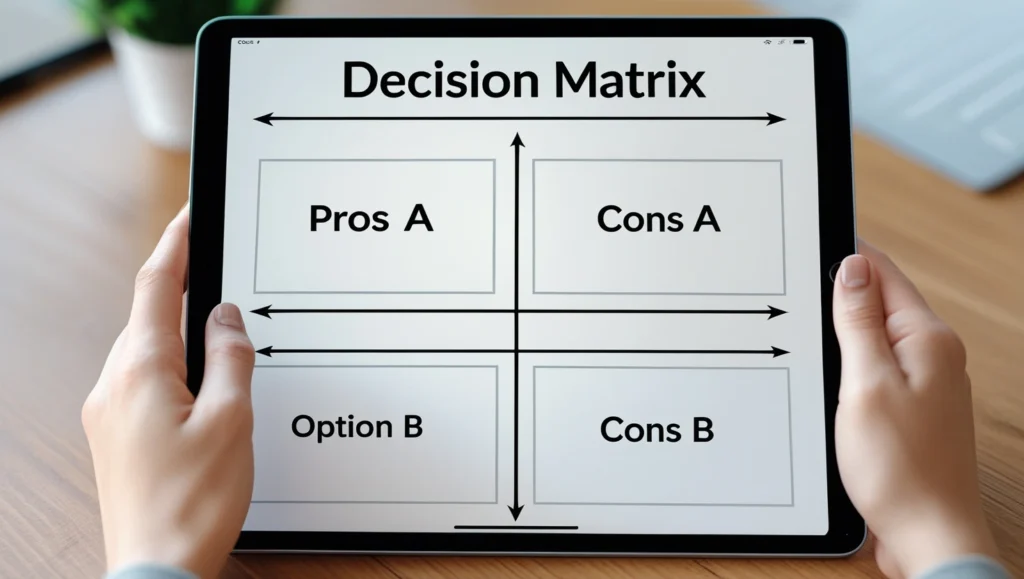The AI Decision-Maker: A Powerful Guide to Better Business Choices
This framework is the key to effective AI for decision making because it structures your thinking. Using AI for decision making has become a game-changer for any professional. Did you know that executives spend nearly a quarter of their time making decisions, yet only 20% of those choices are supported by adequate analysis? This guide introduces a powerful prompt and a framework for AI for decision making that transforms complex choices into structured, data-driven analyses. This is a key part of our The Ultimate Guide to AI for Wellness.
The Science Behind Using AI for Decision Making
Cognitive psychology reveals that humans suffer from predictable biases like “confirmation bias” or “analysis paralysis.” While frameworks help, an AI business analysis tool can process multiple variables objectively, acting as a virtual consultant without the emotional attachments that often compromise human judgment.
The AI Decision-Maker: A Prompt Framework
This framework helps you get the most out of your AI partner by structuring your request. It’s built on four key ideas:
- Comprehensive Context: It ensures the AI understands your specific situation.
- Multi-Perspective Evaluation: It examines decisions through financial, operational, and strategic lenses.
- Scenario Planning: The AI is prompted to generate a range of potential outcomes, including the most favorable, the least favorable, and the most probable.
- Implementation Reality Check: It evaluates how feasible the decision is to execute.
The Complete AI Decision Analysis Prompt

Here’s the comprehensive prompt that transforms any business choice into a structured analysis.
The Master Prompt:
Act as a senior business strategist with expertise in decision analysis and risk assessment. I need you to analyze a business decision using the framework below.
1. CONTEXT:
- Decision to Analyze: [State your specific decision clearly]
- Key Stakeholders & Priorities: [Who is affected, and what are our top 3 priorities?]
- Option A: [Describe the first choice clearly]
- Option B: [Describe the second choice clearly]
2. ANALYSIS (for each option):
- Pros: List the main advantages.
- Cons: List the main disadvantages.
- Hidden Risks: Identify 2-3 potential hidden risks.
3. SCENARIO PLANNING (for each option):
- Briefly describe the best-case, worst-case, and most-likely outcome.
4. RECOMMENDATION FRAMEWORK:
- Do NOT make the decision. Instead, provide 3 strategic questions I should answer to make the final choice myself.
Real-World Applications: 5 Business Scenarios
To see how practical AI for decision making can be, let’s look at five real-world scenarios.
Scenario 1: Product Launch Timing
A SaaS founder used this prompt and discovered that launching immediately would capture 15% more market share, proving more valuable than waiting for perfect features.
Scenario 2: Market Expansion Strategy
An e-commerce company used this framework to evaluate expanding into Europe. The AI uncovered hidden regulatory costs but also identified an underserved niche with 40% higher margins.
Scenario 3: Technology Investment Decisions
A manufacturing firm used a pros and cons AI prompt to choose between upgrading systems or buying new automation tech, revealing a break-even point at 18 months.
Scenario 4: Hiring and Team Restructuring
A startup’s analysis showed that investing in junior training created better long-term value through loyalty and 40% lower ongoing costs.
Scenario 5: Partnership Evaluations
A marketing agency evaluated a merger and the analysis revealed significant cultural challenges, leading them to form a strategic partnership instead. This is a key skill for leading a hybrid team with AI.
Advanced Customization and Common Mistake:
To get the best results, always provide specific context (“Garbage In, Garbage Out”). You can also customize the prompt for your industry. The biggest mistake is to over-rely on the AI; use its insights as input for your final human judgment, a principle we cover in our article on AI for Process Improvement.
Frequently Asked Questions
How long should I spend providing context to the AI?
Invest 10-15 minutes in a detailed context setup. This upfront time typically saves hours of analysis and leads to much better results.
Can this framework work for personal decisions?
Absolutely. This framework for AI for decision making adapts well to significant personal decisions like career changes or major purchases. You just need to adapt the context to reflect your personal objectives.
What is the best practice for handling confidential information with this AI prompt?
Anonymize specific details. Instead of “Should we acquire CompanyX for $5M,” frame it as “Should we acquire a competitor with X market share.”








One Comment